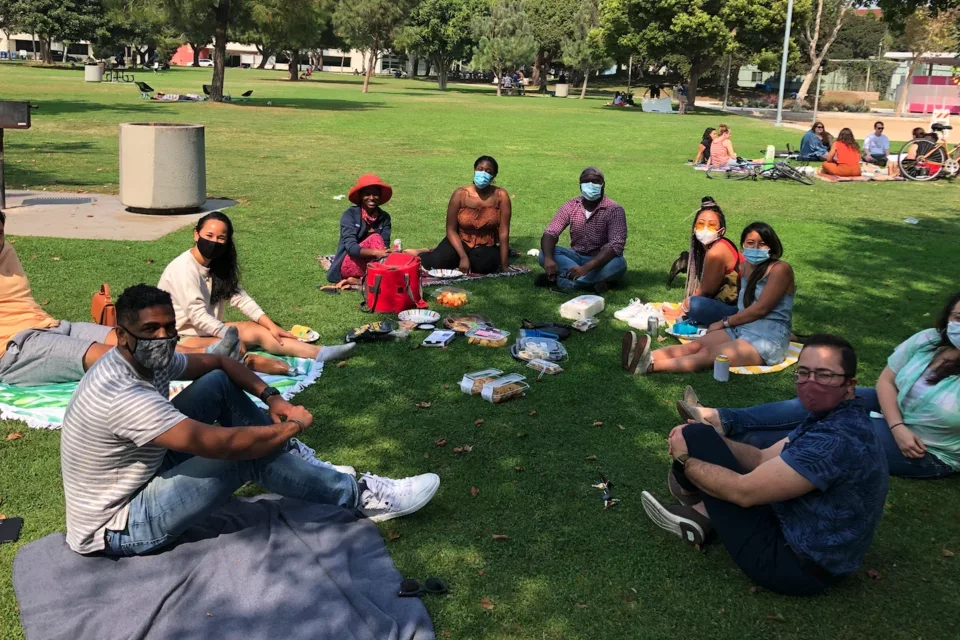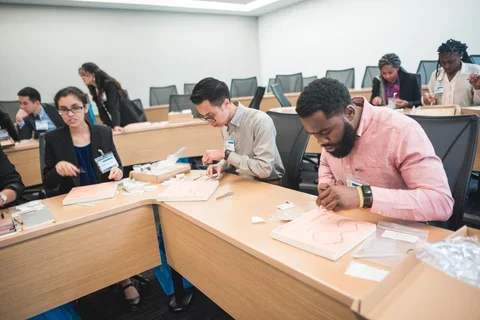Flexwork at DGSOM
Alert
An evolving workplace.
Marrying community engagement and work-life balance.

In 2021, we launched a flexwork strategy to provide greater work-life balance, promote personal responsibility, reduce our environmental footprint and ensure that we remain competitive in a rapidly evolving job market. Our top priority remains ensuring equitable arrangements, building a sense of community in virtual environments, balancing different workstyle preferences, and more. We will continue to collect data and continually evaluate the strengths and weaknesses of flexwork arrangements.
As we look forward, the DGSOM will continue to align with UCLA in implementing a school-wide flexwork strategy that is equitable, data-driven, productive, and – as the name indicates – flexible. Your continued collaboration and problem-solving mindset will be essential to our success in this...

Alert
Defining flexwork at the DGSOM
In alignment with UCLA's definition: Flexwork is a framework that guides alternatives to the standard eight-hour, in-person, office-based daily schedules that were the norm prior to the COVID-19 pandemic. This includes
The employee agrees to use a designated alternate work site that enables the employee to perform work comparable to that practiced at a typical work station at UCLA Health and complies with all necessary safety and security. The terms "telework," "remote work," and "telecommuting" are used interchangeably.
The employee follows a standard eight-hour, in-person, office-based daily schedule.
The employee is on site when necessary to support the business needs. Otherwise, they perform their work at their designated remote location. When needed on site, the department may provide a hoteling-style office space and equipment rather than fixed spaces/offices. Managers may require employees to work on site on specific days or come on site for specific functions. For example, the manager may determine that employees need to participate in person in scheduled staff or client meetings.
The employee maintains a regular on-site and remote schedule. Telecommuting days may not be carried over (i.e. from week to week or month to month) nor may they be saved for use at another time. Managers retain the right to require employees to work on-site on specific days (i.e. to participate in person in scheduled staff or client meetings). Managers also retain the right to rotate fixed schedules based upon business need.
As outlined in UCLA’s flexwork policy and per the UC Personnel Policy for Staff Members, departments have the flexibility to establish alternate work schedules when determining whether hybrid approaches to flexwork will be effective in departments that need some employees to be onsite for a portion of their time, while keeping in mind the legal requirements of the Fair Labor Standards Act (FLSA) regarding exempt and non-exempt status, as specified in PPSM-30.
Alternate full-time work schedules may include:
- 9-hour workdays for an exempt employee, with either a half day off each week or a full day off every other week (“9/80 schedule”);
- 10-hour work days four days per week(“4/10 schedule”); or a
- “Split” schedule, in which an employee works, for example, from 8:00 a.m. to 12:00 p.m., stops working in the middle of the day, and resumes working from 3:00 p.m. to 7:00 p.m
*Alternate work schedules do not include reduced appointments or reduced work hours. Employees who wish to reduce their appointment percentages may request participation in the Employee-Initiated Reduction in Time Program (ERIT), or a regular appointment reduction. ERIT and regular appointment reductions are subject to departmental approval.
Safety Information for Those Onsite
- Required COVID-19 prevention training
- UCLA COVID-19 Prevention Program and Standards
- Standard Operating Procedure for Responding to COVID-19 Cases on Campus
- UCLA return to campus plans
- Physical distancing and face mask expectations
- COVID testing and symptom monitoring requirements
- UCLA COVID-19 Community Screening Protocol
- UCLA COVID-19 Symptom Monitoring System
- Employee density expectations
- Classroom density expectations
- Vaccine requirements
- COVID-19 downloadable signage
- UCLA’s Health and Safety website
- COVID-19 Reporting Resources website
Flexwork Process and Documentation
Eligibility Criteria for Flexwork at the DGSOM
The primary criterion for determining whether telework is appropriate for any employee is whether or not the arrangement meets the department’s business needs. Telework arrangements must not negatively impact colleagues’ workload or productivity by shifting burdens, creating delays or adding steps in the workflow.
Telework is not suitable for all employees. Telework eligibility will depend on the department’s operations and an employee’s job function. Certain jobs can only be performed onsite, with telework not feasible. In addition, employees who telework must be available to travel to their primary worksite when necessary, regardless of the established remote work schedule.
While guidance will vary depending on the faculty member’s roles and responsibilities, faculty leaders should begin by using the following guidelines when evaluating faculty-initiated telecommuting requests:
1. Does the faculty member have clinical/patient-facing duties?
If so, faculty are advised to follow policies and standards set by the UCLA health system for its hospitals and clinics regarding return-to-onsite-work.
2. Is the individual an academic appointee/educator?
Faculty with teaching responsibilities are expected to follow UC policy, which states:
“Consistent with the Academic Personnel Manual, collective bargaining agreements, and other policies, to maintain a significant presence on campus in order to fulfill their obligations to students, colleagues, and the University as a whole. As all are aware, the excellence of the University depends on academic appointees and their engagement with the University’s mission, which is largely rooted in common, in-person experiences. Nevertheless, as Fall 2021 will be a period of transition, campuses may determine that some academic appointees may need flexible work arrangements. Campuses are expected to exercise their judgment and utilize principles of equity in making these determinations, by considering an appointee’s job duties and relevant academic and programmatic needs. As much as possible, campuses should refer to the Academic Personnel Manual and the relevant collective bargaining agreements to guide their decision-making in this regard” (June 23, 2021, memo from UC Office of the Provost and Executive Vice President for Academic Affairs).
3. Are you assessing the request of a DGSOM faculty member who may not fall into one of the above categories?
Speak with your Department Chair to determine if/when telecommuting may be appropriate. Department Chairs who require additional guidance should consult with DGSOM Academic Affairs.
4. Can the faculty member be effectively managed in a remote setting?
For faculty-initiated telecommuting requests, please begin by reading the criteria listed in questions 1-3 above. Per UC and UCLA health system policies, faculty/academic appointees are expected to maintain a significant presence on campus. Outside of these groups, individual requests and assessments for hybrid arrangements are made at the level of the Department Chair and will require the submission of an “Employee-initiated telework proposal.”
In addition to the considerations outlined below, supervisors may also consider the following when determining whether an individual faculty member’s performance/productivity can be effectively managed in a remote setting:
- Is the faculty member facing disciplinary/corrective actions?
- Does the faculty member currently meet the responsibilities of instruction (e.g., as defined in Faculty Code of Conduct: any significant failure to adhere, without legitimate reason, to the rules of the faculty in the conduct of courses, to meet class, to keep office hours, or to hold examinations as scheduled)?
- For research faculty, have supervisors observed a general trend of research productivity as assessed in that specific department/division?
For research faculty outside the United States: A faculty member overseeing research activities via telework will be expected to comply with the rules and regulations established by the funding agencies supporting that research, as well as with UCLA's policies.
5. Has the faculty member exhibited a working style suitable to telework?
Successful telecommuters are typically self-motivated, have the technical skill set to work with telecommuting tools (or can be trained quickly) and have strong time management skills.
If the faculty member has participated in remote work during the pandemic, have they exhibited best practices?Examples include:
- Responding to colleagues, emails, calls and requests in a timely manner
- Participating in virtual meetings with their video on, indicating high engagement and transparency
- Dressing professionally
- Exhibiting professional meeting etiquette (not distracted by emails, phone, environmental factors, etc.)
- “Arriving” on time to meetings
- Utilizing Zoom chat function to engage with colleagues and add to the conversation
- Maintaining strong, communicative relationships with colleagues, colleagues and peers
- Attending virtual team-building events
- Learning and utilizing key remote-work technical capabilities (screen-sharing, scheduling Zoom meetings, etc.)
1. Can the work be successfully performed in a remote setting?
Positions that can be regularly performed remotely are those that don’t require a traditional office or clinical space to deliver their service and do not require in-person interactions with internal and external customers/colleagues.
Jobs that entail working with equipment that can be easily moved to an alternate worksite are often more suitable for remote work. Examples include, but are not limited to:
- Writers
- Editors
- Analysts
- Programmers
- Post-docs engaged in research, writing and study activities that can be performed effectively in a remote or hybrid-remote context
Work that can be performed remotely may still require some onsite presence for purposes of team-building, training or other activities that are more suitable for in-person settings. These types of activities are determined by the manager/department leadership.
Jobs that require physical presence or constant interaction with clients and coworkers may not be suitable for remote work. Examples include, but are not limited to:
- Mail processors
- Grounds keepers
- Lab workers
- Patient-facing clinical personnel
- Educators (see “faculty guidelines”)
2. Can the employee be effectively managed in a remote setting?
Supervisors should be able to monitor and assess productivity.
For staff-initiated telecommuting agreements, staff must maintain a rating of at least “Effective” or “Meets Expectations” on their most recent performance evaluation. Employees under active performance management may not be allowed to participate.
For telecommuting agreements initiated by postdoctoral scholars, participation in flexwork requires the following: 1) the faculty supervisor should be able to adequately assess progress, 2) the post-doc should currently be meeting their academic and/or research progress goals, and 3) the post-doc should maintain a rating of “meets expectations” on annual evaluations. These requirements should continue to be monitored and tracked while telecommuting.
3. Has the employee exhibited a working style suitable to telework?
Successful telecommuters are typically self-motivated, have the technical skill set to work with telecommuting tools (or can be trained quickly) and have strong time management skills.
If the employee has participated in remote work during the pandemic, have they exhibited best practices? Examples include:
- Responding to colleagues, emails, calls and requests in a timely manner
- Participating in virtual meetings with their video on, indicating high engagement and transparency
- Dressing professionally
- Exhibiting professional meeting etiquette (not distracted by emails, phone, environmental factors, etc.)
- “Arriving” on time to meetings
- Utilizing Zoom chat function to engage with colleagues and add to conversation
- Maintaining strong, communicative relationships with colleagues, colleagues and peers
- Attending virtual team-building events
- Learning and utilizing key remote-work technical capabilities (screen-sharing, scheduling Zoom meetings, etc.)
Working with medical conditions or disabilities
All telework requests related to a medical condition or disability should be referred to Employee Disability Management Services.
Working outside of California
Guidance from the University of California does allow out-of-state telework agreements under the following conditions:
1) The individual meets the same eligibility criteria listed above (including agreeing to travel to the primary onsite work location when required), and
2) the employee has reviewed and understands any implications associated with out-of-state telework, including potential differences in health and welfare benefits, compensation, payroll, tax withholdings, etc. Learn more >>
Additional local guidelines forthcoming.
Working outside the U.S.
Guidance is forthcoming. Check back soon.
Tools and Training
One key component of flexwork is the ability to work remotely. To help those working, learning or teaching offsite, as well as those managing remote teams, we’ve provided a number of resources that are designed to ensure your continued success in a virtual work/learning environment.

UCLA Health CORE
See Training